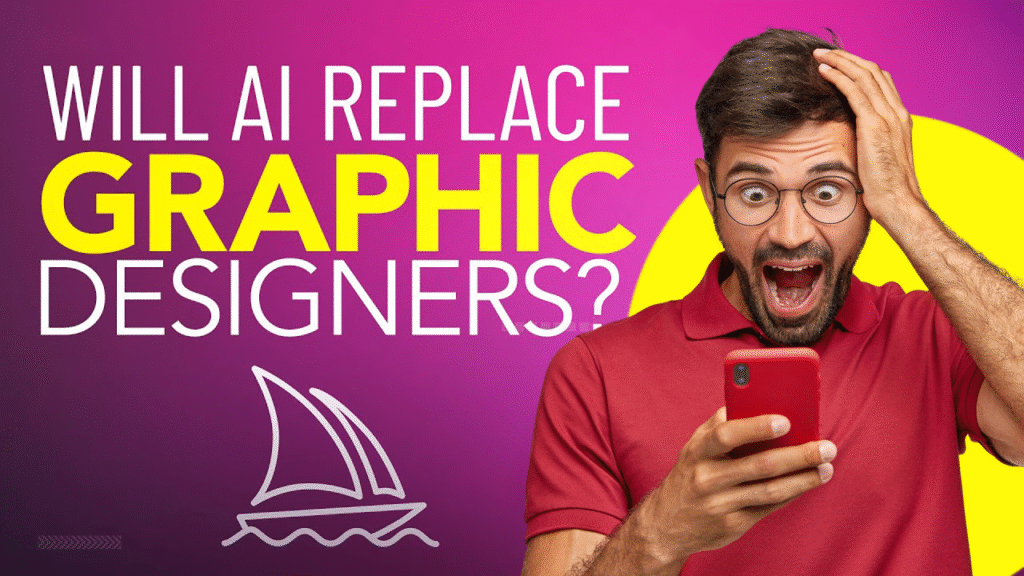Artificial Intelligence is no longer just a futuristic buzzword—it’s everywhere. From self-driving cars to chatbots answering your customer service questions, AI is reshaping industries at lightning speed. One of the hottest debates right now is whether AI can replace creative jobs, especially graphic design.
Scroll through social media and you’ll see AI art tools producing logos, posters, and illustrations in seconds. Some people celebrate it as innovation, while others fear it spells the end of human creativity. But what’s the reality?
Let’s dive into the truth about AI and creative jobs—and whether graphic designers should be worried or excited about the future.
Why AI in Graphic Design Feels Like a Threat
AI-powered design tools such as MidJourney, Canva AI, DALL·E, and Adobe Firefly can instantly generate visuals based on text prompts. You simply type, “Create a futuristic logo with neon colors,” and voilà—a polished design appears.
This raises some important questions:
-
If AI can create logos in seconds, why would anyone hire a designer?
-
Does this mean design as a career is dying?
-
Will creative jobs even exist 10 years from now?
These concerns are valid, but they don’t tell the whole story.
What AI Does Well in Graphic Design
Let’s give credit where it’s due. AI tools are powerful, and they’re transforming the design process in several ways:
-
Speed and Efficiency – AI can produce designs in minutes that might take hours manually.
-
Idea Generation – Designers can use AI as a brainstorming partner for creative inspiration.
-
Low-Cost Options – Small businesses with tight budgets can use AI to create basic visuals without hiring professionals.
-
Repetitive Tasks – Background removal, resizing images, or color correction can now be automated.
AI thrives when the task is clear, repetitive, and rule-based.
Where AI Falls Short
Despite the hype, AI has serious limitations when it comes to graphic design:
-
Lack of Originality – AI generates based on existing data. It can remix styles, but it can’t invent a completely new design language.
-
No Context or Strategy – A logo is not just “pretty art”—it represents brand values, audience psychology, and market positioning. AI can’t capture this depth.
-
Copyright and Ethics Issues – Many AI models are trained on existing artwork without permission, raising legal and ethical concerns.
-
Human Touch – Design is more than visuals—it’s storytelling. AI struggles with emotional resonance.
In short, AI is a tool, not a visionary.
Why Businesses Still Need Human Graphic Designers
Even as AI tools become smarter, businesses still turn to human designers for critical reasons:
-
Brand Strategy Matters – A designer doesn’t just make things look good—they align visuals with brand identity.
-
Collaboration is Key – Clients want conversation, brainstorming, and revisions—things AI can’t offer.
-
Trust and Originality – Companies want assurance that their design is unique and legally safe.
-
Complex Projects – AI can design a quick Instagram post, but can it manage an entire rebranding campaign? Not yet.
The truth is, companies need designers who understand people, not just pixels.
The Future: Collaboration, Not Replacement
Here’s the exciting part: AI isn’t replacing designers—it’s changing how they work. Think of AI as a powerful assistant rather than a competitor.
-
Faster Workflows – Designers can use AI to handle boring, repetitive tasks while focusing on creative strategy.
-
New Roles Emerging – “AI Art Director” or “Prompt Engineer for Design” are becoming actual job titles.
-
More Opportunities – Small businesses that once couldn’t afford design services now experiment with AI, eventually realizing they need human experts for serious projects.
In other words, AI expands the playground for creative professionals.
How Designers Can Stay Future-Proof
Instead of fearing AI, designers should adapt. Here are key strategies to stay ahead:
-
Learn AI Tools – Treat them as part of your toolkit, just like Photoshop or Illustrator.
-
Focus on Strategy – Offer brand consulting, storytelling, and marketing insights that AI can’t replicate.
-
Specialize – Niche areas like motion graphics, packaging design, or UX/UI still require deep human expertise.
-
Develop Soft Skills – Communication, empathy, and creative thinking are more valuable than ever.
-
Stay Ethical – Clients trust designers who can guide them through the legal and cultural implications of AI design.
The more you blend creativity + strategy + tech, the more irreplaceable you become.
A Realistic Look: Who Wins, Who Loses?
-
Winners: Designers who adapt, learn AI, and focus on big-picture creativity.
-
Losers: Those who only offer basic, repetitive design work without adding strategic value.
Think about it: Canva didn’t eliminate designers—it actually increased demand for higher-quality custom design once businesses realized templates weren’t enough. AI will likely follow the same path.
Beyond Graphic Design: The Bigger Picture
This debate isn’t just about designers—it’s about the future of all creative jobs:
-
Writers worry about ChatGPT.
-
Musicians worry about AI-generated music.
-
Photographers worry about stock image generators.
But history shows us something important: every major technology shift creates new opportunities.
-
When cameras were invented, people thought painting would die. Instead, art evolved.
-
When digital tools arrived, designers feared for their jobs. Instead, design became more global.
AI is the next chapter in this story—not the end of it.
Final Thoughts
So, can AI replace graphic designers?
The honest answer is: AI can replace some tasks, but not entire careers. It’s fantastic at generating quick visuals, but it lacks the human creativity, strategy, and empathy that great design requires.
The future isn’t AI vs. humans—it’s AI + humans. Designers who embrace AI will thrive, while those who resist change may struggle.
If you’re a designer, don’t fear AI. Learn it, master it, and use it as your creative sidekick. The truth is, the world will always need human imagination—and no algorithm can fully replace that.
